
What is Filipino? Jiggy and Marnie Manicad seek for answers in Netflix docu-series
What makes something Filipino? What makes preparing food, designing homes or making music uniquely Filipino? These are some of the questions that husband-and-wife team Jiggy and Marnie Manicad seek to answer in their newest documentary series, “I Love Filipino,” which debuts today on Netflix — fittingly timed with the Philippine Independence Day.
More than just a documentary, “I Love Filipino” serves as a love letter to Filipino identity — an exploration of culture and heritage through everyday details that are often overlooked. For the docu-series host-writer Jiggy and producer-director Marnie, the project began with one central question: What is Filipino?

Jiggy in a Quiapo Church scene from the docu-series.
“Ano nga ba yung Filipino now? What is Filipino food? What is Filipino music? What is Filipino?” Marnie said in an exclusive interview with The STAR.
“So, we thought of coming up with a documentary that eventually became a docuseries because of the many topics we wanted to talk about. Lahat geared towards answering that question. Hopefully, when Filipinos watch it, they will feel or see even a glimpse of the answer to that question.
“Team MMPI — our company that produced the documentary series — has always been on the lookout to best serve God and country. And the best way to do that is to create content that is educational, uplifting and deeply rooted in our culture and heritage.”
Focus on the basics
The concept might sound overwhelming, but the series unpacks it through five episodes focusing on the “essentials” of the Filipino experience. These are “Pinoy Altanghap” (food), “Himig” (music), “Juan with Art” (visual arts), “SawsawJuan” (dipping sauces) and “Bahay Kubo” (architecture).
According to Jiggy, the idea wasn’t born from a singular event, but rather from everyday observations that sparked these thought-provoking questions.
For “Pinoy Altanghap,” something as ordinary as eating out became a jumpoff point of reflection.
“For example, kakain ka pero parang mas marami pang foreign cuisine kesa Filipino? Bakit parang mas sikat ang foreign? Bakit mas hinahanap natin?”
One surprising insight for him while filming in Cebu was how well-developed local food was even before the Spanish came.
Shooting the “Bahay Kubo” episode was likewise an eye-opener. “In Europe, may identity ang architecture. If we see something nice abroad, we apply it here. So we asked: Meron ba talaga tayong sariling Filipino architecture?”
Apparently, yes. The bahay kubo, often associated with rural or low-income life, he learned, has long been used by National Artists as a model for efficient design suited to the Philippine context.
“It’s like they deconstructed it… For example, large windows, tilted roofs, wide spaces — you can now see these in modern architecture,” said Jiggy.
In “Juan with Art,” the series shows that the Filipino art canon goes beyond historical masterpieces.
“The most popular is parating Spoliarium, Juan Luna. Pero kumusta ‘yung contemporary? Meron ba nabubuhay (is it thriving)? It turned out, meron and they’re really good.”
The “Himig” episode poses its own questions about cultural identity.
“Meron ba tayong matatawag na sariling atin in terms of music? Maraming mga artist na magagaling pero struggling pa rin tayo kung paano tayo aangat sa world stage… so paano ‘yun?”
“I Love Filipino” also explores Filipino quirks such as obsession with sawsawan or dipping sauces.
“Gravy, ginagawa nating sabaw. Ice cream, ginagawang sawsawan. Bulalo, ‘di pwedeng walang sawsawan,” Jiggy said. “Bakit ba ang Pinoy mahilig sa sawsawan?”

The host with Chef Miggy Moreno, promoter of Tausug dishes.
Creative tandem
Asked how they work together creatively, Marni said the division is clear.
“Jiggy is more on the research and script side. I give suggestions on content but the final script comes from Jiggy,” she shared.
Marnie, on the other hand, is in charge of the production side, from location shoot, production design, to “whether there will be a re-enactment or real-time shoot.”
Forming part of the team are Emmy award-winning composer Denise Santos, Raffy Magsaysay for sound design and Marilyn Magsaysay for color grading.
“Our partnership works because we don’t overstep each other’s territory. We respect each other’s craft. I really admire how Jiggy wrote this piece,” Marnie praised her husband.
To which Jiggy quipped, “Oh? Sige nga, pa-kiss nga diyan (laughs)!”
Jiggy shared that the brainstorming for projects often starts during breakfast conversations. He’s usually the one to ask, “Kaya ba nating gumawa ng ganito?” and when Marnie says, “Sige, kaya,” that’s when they begin to pursue the idea.
Based on their stories, their journey with “I Love Filipino” was as much a spiritual process as it was a creative and journalistic one.
“When I wrote the script, I had to have clarity of mind — free from prejudice and distractions. We had to present the material as truthfully and honestly as we could and we could only achieve that if we prayed for the material,” Jiggy shared.
“Before we begin (any project), before I jump into the research or start outlining the material, we always pray about it first. Because the important thing is if the Lord wants the project to push through. We entrust it to His will.
“At the end of the day, even when it’s done, you still pray: ‘I hope someone watches. I hope they like it.’ So the praying really needs to start from the beginning.”
Global platform for a Pinoy story
The Manicads are no strangers to global releases. Their earlier work, “Inside Malacañang,” got aired on National Geographic, translated into 40 languages and nominated for an Emmy.
Initially, “I Love Filipino” was meant for Netflix Philippines. “Then, I received an e-mail that it was being translated to Thai, Vietnamese…” Marnie recalled.
“When I learned it was for global release, I thanked God. It is really an offering to Him… I really feel very blessed to be working on the project, and I just pray that a lot of people will be able to watch it.”
For non-Filipino audiences, she said that “maybe this is also a window for them.”
“Because when you say Philippines, ‘Di ba traffic d’yan? Pangit airport niyan?’ ‘Di ba ‘yan ‘yung mga unang naiisip ng mga foreigners. But the beauty of the Filipinos — the warm smiles, the food we offer and everything else — it’s not being put on the pedestal. We wanted to magnify it through this documentary and hopefully it translates.”
Jiggy added that for the longest time, Filipinos have viewed themselves as a third world country and that’s also how others have seen them. That perception, he pointed out, doesn’t reflect the entirety of the Filipino people — that the Philippines is a “dugyot (messy)” nation.
What he and his team wanted to present, he said, was the human face of the story.
“Pag dinaan mo sa tao ‘yan — tayo, ‘di ba, ‘yung isa sa pinakamasaya, pinaka-friendly. But we have to highlight those traits. Because this is what we can offer — ‘yung puso ng Pilipino (the heart of a Filipino),” said the TV5 news anchor and six-time New York Festivals and Peabody winner.
“One of the architects we interviewed said, ‘No one can truly build up the Filipino except fellow Filipinos.’ And I really believe that’s true.
“Yun ang gusto kong maipaabot sa kanila. Maraming maganda sa atin. Maraming mabuti. Maraming maayos. At ito na ‘yung panahon para magbago na ‘yung pananaw ninyo.”
“I Love Filipino” is now streaming on Netflix.
Source: What is Filipino? Jiggy and Marnie Manicad seek for answers in Netflix docu-series



